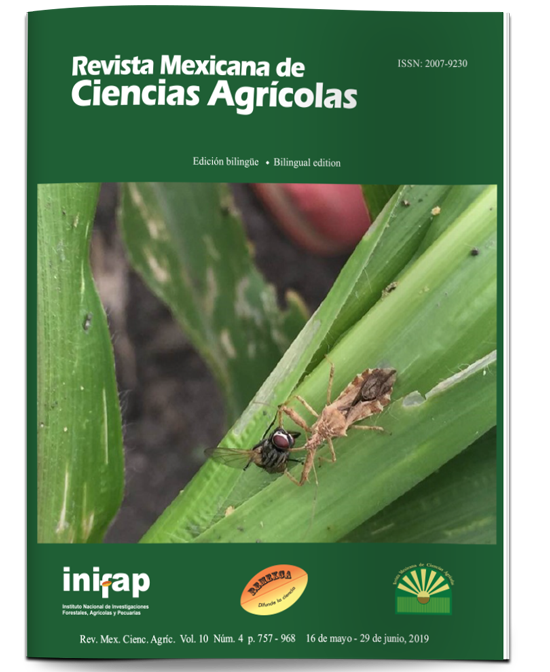Antiserum vs phytopathogenic fungi in the tomato crop in Sonora, Mexico
DOI:
https://doi.org/10.29312/remexca.v10i4.1706Keywords:
antiserum, detection, fungi, phytopathogenAbstract
Phytosanitary problems are to a large extent the cause of global economic losses in agricultural crops, which are mainly caused by fungi. In the Mexican Republic, specifically in the state of Sonora, Mexico, the area directed to the tomato crop has increased considerably in recent years. In the last production cycles, a problematic of phytosanitary control has been generated, where the symptoms of known pathogens, are confused with those of ‘new’ phytopathogens that are arriving to the agricultural areas, allowing the technician to have uncertainty of which pathogen treats and therefore does not succeed in applying a control in the crop. Going to professional services in phytosanitary laboratories, the demand too much, is usually an unaffordable way to the producer. The objective of the present investigation was to identify the causative agents of diseases: Fusarium oxysporum f. sp. lycopersici (Race 1), Alternaria solani and Botritys cinerea on the sampled organs to know the current phytosanitary status of the tomato crop in the state of Sonora, to seed, seedling, foliage and physiological maturity, isolating and identifying them by means of the combination of diagnosis (production of antisera in New Zealand race rabbits, techniques for the use of culture media, Elisa and pathogenicity tests). The sampling for the identification of phytopathogenic fungi was carried out representatively in tomato producing regions. The results obtained show the identification of three representative fungi of economic importance in the tomato crop distributed in the state of Sonora. It is concluded that separate screening tests should not be used as a single detection method.
Downloads
Downloads
Published
How to Cite
Issue
Section
License
The authors who publish in Revista Mexicana de Ciencias Agrícolas accept the following conditions:
In accordance with copyright laws, Revista Mexicana de Ciencias Agrícolas recognizes and respects the authors’ moral right and ownership of property rights which will be transferred to the journal for dissemination in open access. Invariably, all the authors have to sign a letter of transfer of property rights and of originality of the article to Instituto Nacional de Investigaciones Forestales, Agrícolas y Pecuarias (INIFAP) [National Institute of Forestry, Agricultural and Livestock Research]. The author(s) must pay a fee for the reception of articles before proceeding to editorial review.
All the texts published by Revista Mexicana de Ciencias Agrícolas —with no exception— are distributed under a Creative Commons License Attribution-NonCommercial 4.0 International (CC BY-NC 4.0), which allows third parties to use the publication as long as the work’s authorship and its first publication in this journal are mentioned.
The author(s) can enter into independent and additional contractual agreements for the nonexclusive distribution of the version of the article published in Revista Mexicana de Ciencias Agrícolas (for example include it into an institutional repository or publish it in a book) as long as it is clearly and explicitly indicated that the work was published for the first time in Revista Mexicana de Ciencias Agrícolas.
For all the above, the authors shall send the Letter-transfer of Property Rights for the first publication duly filled in and signed by the author(s). This form must be sent as a PDF file to: revista_atm@yahoo.com.mx; cienciasagricola@inifap.gob.mx; remexca2017@gmail.
This work is licensed under a Creative Commons Attribution-Noncommercial 4.0 International license.



